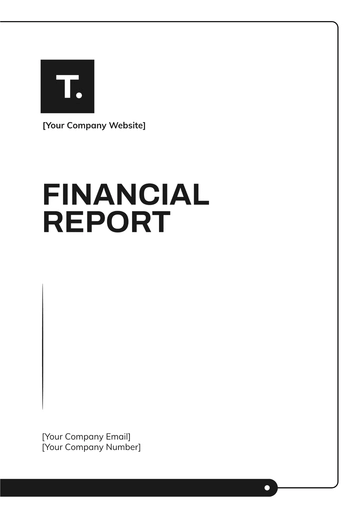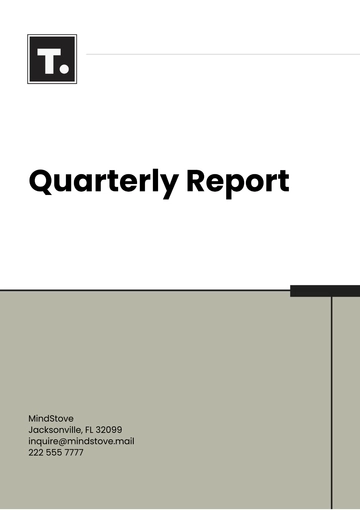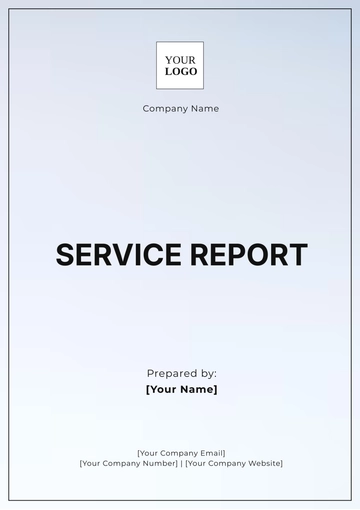Free CEO Report

1. Introduction
As we enter the year [2050], [Your Company Name] is reflecting on a year of growth and resilience, even in the face of global challenges. The business environment has been unpredictable, with fluctuating demand in certain sectors, supply chain disruptions, and geopolitical tensions impacting industries worldwide. Despite these difficulties, we have emerged stronger, thanks to our unwavering commitment to innovation, customer satisfaction, and operational efficiency.
This report provides an extensive analysis of our performance, covering key areas such as financial results, strategic initiatives, operational review, and market outlook. The following sections aim to give an in-depth understanding of where we stand and where we are heading, detailing the various steps we are taking to ensure continued success and sustainable growth in the coming years.
2. Executive Summary
2.1 Financial Performance
In the past year, [Your Company Name] demonstrated exceptional financial performance, outpacing expectations despite a challenging economic landscape. Our total revenue for the year reached $[250 million], reflecting a [20]% increase from the previous year. This growth was driven by our strategic focus on expanding into new markets, increasing sales in high-demand regions, and leveraging technology to optimize operations.
Our profitability also saw significant improvement. The net profit stood at $[40 million], a [15]% year-over-year increase. This was a direct result of not only increasing revenue but also our continued focus on managing costs and improving operational efficiencies. We successfully reduced production costs by [5]% through the use of automation and digital tools, which has allowed us to maintain a healthy bottom line.
2.2 Strategic Achievements
A core component of our success over the last year has been the execution of strategic initiatives that have enhanced our market position and driven sustainable growth. These include expanding into high-growth regions such as Asia and Africa, and enhancing our technological capabilities. Through the successful launch of new partnerships and ventures in these markets, we saw a [25]% increase in revenue from these regions alone.
In addition, our strategic focus on digital transformation has yielded tangible results. Investment in advanced technologies like artificial intelligence (AI) and machine learning has streamlined operations, improved decision-making processes, and enhanced customer experiences. Our digital platforms have driven customer engagement, leading to a [15]% increase in repeat business.
3. Financial Overview
3.1 Revenue Growth
[Your Company Name] experienced a strong increase in revenue across all regions. North America remains our largest market, contributing [36]% of total revenue, followed by Europe at [28]%. However, our expansion into Asia and Africa proved to be particularly successful, with revenue from these regions growing by [30]% and [25]%, respectively. The continued strength of our core product lines, combined with new offerings tailored to emerging markets, has driven this growth.
Region | Revenue ($) | Percentage of Total Revenue |
|---|---|---|
North America | 90 million | 36% |
Europe | 70 million | 28% |
Asia | 50 million | 20% |
Africa | 40 million | 16% |
Total | 250 million | 100% |
3.2 Profitability and Margins
Our efforts to increase profitability through strategic pricing and cost management have borne fruit. The gross margin expanded to [32]% from [30]% in the previous year. This growth was driven by a higher-margin product mix and efficiencies gained from our investments in automation and digitalization. Furthermore, operating profit rose by [12]%, reflecting better cost controls and increased sales volume.
Profitability Metric | Previous Year ($) | Current Year ($) | Change |
|---|---|---|---|
Gross Profit | 68 million | 80 million | 18% |
Operating Profit | 45 million | 50 million | 12% |
Net Profit | 35 million | 40 million | 15% |
3.3 Cost Management and Efficiency
Cost control remains a priority, and we have been able to achieve solid gains in this area. While our overall operating costs increased by [5]% to $[170 million], this increase was less than the increase in revenue, reflecting our ability to improve efficiency. Automation, in particular, has helped reduce labor costs by [7]% and allowed us to maintain high levels of output with fewer resources. Additionally, renegotiated supplier contracts and better inventory management have further contributed to cost reductions.
Cost Category | Previous Year ($) | Current Year ($) | Change |
|---|---|---|---|
Raw Materials | 75 million | 80 million | 7% |
Labor Costs | 32 million | 30 million | 6% |
Logistics & Shipping | 28 million | 25 million | 10% |
Administrative Costs | 15 million | 15 million | 10% |
Total Operating Costs | 170 million | 170 million | 5% |
3.4 Cash Flow and Liquidity
Our liquidity position remains solid. Operating cash flow for the year increased by [10]% to $[45 million], driven by higher profits and improved working capital management. Free cash flow also grew by [12]% to $[25 million], reflecting our ability to generate cash after capital expenditures. This strong cash flow positions us well for continued investment in growth initiatives and shareholder returns.
Cash Flow Metrics | Previous Year ($) | Current Year ($) | Change |
|---|---|---|---|
Operating Cash Flow | 40 million | 45 million | 10% |
Capital Expenditures | 18 million | 20 million | 8% |
Free Cash Flow | 22 million | 25 million | 12% |
4. Strategic Initiatives
4.1 Market Expansion and New Partnerships
One of the cornerstones of [Your Company Name]'s growth strategy has been our commitment to expanding our global footprint. This expansion has been particularly evident in our focus on high-growth emerging markets, where we have forged strategic partnerships and established new offices in key regions.
In [2050], our push into Asia, Africa, and Latin America proved highly successful. Through partnerships with established local businesses and targeted market entry strategies, we have been able to offer our products and services to a new wave of consumers. For instance, in China, where we launched a joint venture with a leading tech firm, we saw revenue growth of [30]% compared to last year, contributing an additional $[20 million] to our total revenue. Similarly, in India, we partnered with regional distributors to enhance our presence in smaller cities, which resulted in a [25]% increase in sales from the region.
Africa has been another area of significant growth, driven by partnerships with local companies in countries such as Nigeria and South Africa. With revenue from Africa rising by [25]%, we now see the region contributing approximately [16]% of our total global revenue. These markets offer a unique opportunity for us, and the demand for our products continues to rise as economic conditions improve and middle-class populations grow.
This expansion has not only opened new revenue streams but has also allowed us to tailor our product offerings to local needs, further strengthening our global brand. Moving forward, we will continue to explore additional markets in South America and Southeast Asia, where similar trends in population growth and urbanization offer a promising future for our business.
Market Expansion Metrics | Region | Revenue ($) | Percentage Growth |
|---|---|---|---|
China Partnership | Asia | 20 million | 30% |
India Partnership | Asia | 15 million | 25% |
Nigeria Market Entry | Africa | 10 million | 20% |
South Africa Market Entry | Africa | 12 million | 18% |
Total Regional Revenue | - | 57 million | 25% |
4.2 Digital Transformation and Innovation
As part of our ongoing efforts to innovate and stay competitive, [Your Company Name] has made substantial investments in digital transformation. In [2050], this transformation accelerated through the implementation of cutting-edge technologies such as Artificial Intelligence (AI), Machine Learning (ML), Internet of Things (IoT), and robotics, which have collectively reshaped both our production and customer engagement processes.
One of the key areas of focus has been AI-driven demand forecasting, which has significantly reduced excess inventory and optimized stock levels, allowing us to cut waste by [10]%. In production, we’ve integrated IoT sensors across our manufacturing lines, enabling us to collect real-time data and make quicker adjustments, improving overall equipment efficiency by [15]%. This not only helps us improve product quality but also ensures that production lines are more responsive to changing customer demands.
On the customer side, we launched an upgraded e-commerce platform designed to enhance the user experience. This platform uses machine learning algorithms to personalize shopping recommendations, resulting in a [15]% increase in online sales and a [10]% improvement in conversion rates. Additionally, we integrated chatbots and AI-driven customer support, providing faster response times and more efficient issue resolution, which has increased customer satisfaction by [8]%.
We will continue to invest heavily in digital innovation, expanding the use of AI and ML to further refine our product offerings and services. By the end of [2051], our goal is to ensure that [Your Company Name] becomes a fully digitalized organization, with more than [50]% of our processes automated and a greater reliance on data-driven decision-making.
4.3 Sustainability Initiatives
Sustainability has been a central focus for [Your Company Name], and we are committed to achieving environmental responsibility while continuing to grow our business. In [2050], we made significant strides in reducing our carbon footprint, enhancing our recycling initiatives, and increasing the use of renewable energy sources in our operations.
As part of our goal to become carbon-neutral by [2060], we increased our renewable energy usage by [5]%, bringing our total use of renewable sources to [10]%. Additionally, we installed energy-efficient equipment in all our facilities, which has led to a [5]% reduction in energy consumption and a [4]% reduction in overall greenhouse gas emissions.
We also implemented a company-wide recycling program, which saw a [15]% increase in the amount of materials we successfully recycled, bringing the total percentage of waste recycled to [60]%. In terms of product sustainability, we introduced eco-friendly packaging for all our products, which has been met with overwhelmingly positive customer feedback. Over the next decade, we are aiming to reach [90]% recycling rates across our operations and have committed to reducing our carbon emissions by [25]% by [2060].
Sustainability Metrics | Current Status | Goal by 2060 |
|---|---|---|
Renewable Energy Usage | 10% | 50% |
Carbon Emissions Reduction | 5% reduction | 25% reduction |
Waste Recycling Rate | 60% | 90% |
Eco-friendly Product Packaging | 100% | 100% |
5. Operational Review
5.1 Production Efficiency
Efficient production remains a critical area for [Your Company Name]. In [2050], we focused on streamlining our manufacturing processes and implementing automation to increase output while minimizing costs. The integration of robotics into our assembly lines has proven to be a game-changer, allowing us to reduce production time per unit by [10]%.
With the implementation of AI-powered predictive maintenance, we reduced equipment downtime by [20]%, ensuring that our production schedules are more reliable and costs associated with equipment failure are minimized. As a result, our production output increased by [15]% this year, with a total of [115,000 units] produced compared to [100,000 units] the previous year. We have also significantly reduced material waste through smarter manufacturing processes, which decreased waste generation by [8]% from last year.
Our goal is to maintain these gains and continue pushing for greater efficiencies in the coming years. We plan to introduce additional automation technologies in the coming year that will further optimize our production lines and allow us to scale our operations while reducing labor costs and environmental impact.
Production Metrics | Previous Year | Current Year | Improvement |
|---|---|---|---|
Production Output | 100,000 units | 115,000 units | 15% |
Waste Generation | 10,000 units | 9,200 units | 8% |
Production Time per Unit | 5 hours | 4.5 hours | 10% |
5.2 Supply Chain Optimization
Our supply chain underwent significant improvements in [2050], with a focus on reducing lead times, improving inventory turnover, and ensuring timely deliveries. By implementing AI-powered forecasting systems, we were able to better predict demand, which in turn improved stock levels and decreased the risk of stockouts. This contributed to a [12]% improvement in inventory turnover and a [7]% reduction in lead times.
We also invested in supply chain automation, incorporating robotic systems in our warehouses to improve efficiency. This led to quicker order fulfillment, as well as reduced human error in the picking and packing processes. Additionally, strengthening relationships with key suppliers allowed us to better manage global supply chain disruptions, ensuring that we could still meet customer demands despite challenges in raw material availability.
Looking forward, we plan to further optimize our supply chain by leveraging blockchain technology for better transparency and traceability. Our goal is to reduce supply chain costs by [10]% over the next three years while improving delivery times and product availability.
Supply Chain Metrics | Previous Year | Current Year | Improvement |
|---|---|---|---|
Inventory Turnover Rate | 4 times/year | 4.5 times/year | 12% |
Lead Time | 30 days | 28 days | 7% |
Supply Chain Automation | 50% of process | 70% of process | 20% |
5.3 Workforce Development
Investing in our employees remains a top priority for [Your Company Name]. In [2050], we focused on expanding our workforce with an emphasis on hiring individuals with expertise in emerging technologies and digital transformation. This year, we added [500] new hires, bringing our total employee count to [2,500].
We also implemented more extensive training programs to ensure our existing employees were prepared for the future. This includes offering courses in digital skills, AI, and robotics to help our employees adapt to the changing workplace. As a result, we saw a [20]% reduction in employee turnover and a [5]% increase in overall employee engagement, with satisfaction scores reaching an all-time high.
Our commitment to employee development is evident in our investment in leadership programs, which aim to identify and nurture future leaders within the organization. By the end of [2051], we aim to have [10]% of our leadership positions filled by internal candidates who have advanced through our development programs.
HR Metrics | Previous Year | Current Year | Change |
|---|---|---|---|
Employee Headcount | 2,000 | 2,500 | 25% |
Employee Turnover Rate | 10% | 8% | 20% |
Employee Engagement Score | 75% | 80% | 5% |
6. Conclusion
The year [2050] has been one of remarkable progress and strategic achievement for [Your Company Name]. Our commitment to global expansion, innovation, and sustainability has paid off, and we have successfully positioned ourselves for continued growth. The strides we have made in operational efficiency, digital transformation, and workforce development have provided us with a strong foundation for the future.
Looking forward, we will continue to invest in our key strategic initiatives, focusing on expanding into new markets, enhancing our technological capabilities, and reducing our environmental footprint. By staying true to our values of innovation, customer satisfaction, and sustainability, [Your Company Name] is poised to achieve even greater success in the coming decades. The future is bright, and we are ready to meet the challenges and opportunities that lie ahead.
- 100% Customizable, free editor
- Access 1 Million+ Templates, photo’s & graphics
- Download or share as a template
- Click and replace photos, graphics, text, backgrounds
- Resize, crop, AI write & more
- Access advanced editor
Streamline executive reporting with the CEO Report Template from Template.net. This editable and customizable format ensures comprehensive and professional reporting. Make modifications effortlessly with the AI Editor Tool. Download today to deliver impactful updates to stakeholders.
You may also like
- Sales Report
- Daily Report
- Project Report
- Business Report
- Weekly Report
- Incident Report
- Annual Report
- Report Layout
- Report Design
- Progress Report
- Marketing Report
- Company Report
- Monthly Report
- Audit Report
- Status Report
- School Report
- Reports Hr
- Management Report
- Project Status Report
- Handover Report
- Health And Safety Report
- Restaurant Report
- Construction Report
- Research Report
- Evaluation Report
- Investigation Report
- Employee Report
- Advertising Report
- Weekly Status Report
- Project Management Report
- Finance Report
- Service Report
- Technical Report
- Meeting Report
- Quarterly Report
- Inspection Report
- Medical Report
- Test Report
- Summary Report
- Inventory Report
- Valuation Report
- Operations Report
- Payroll Report
- Training Report
- Job Report
- Case Report
- Performance Report
- Board Report
- Internal Audit Report
- Student Report
- Monthly Management Report
- Small Business Report
- Accident Report
- Call Center Report
- Activity Report
- IT and Software Report
- Internship Report
- Visit Report
- Product Report
- Book Report
- Property Report
- Recruitment Report
- University Report
- Event Report
- SEO Report
- Conference Report
- Narrative Report
- Nursing Home Report
- Preschool Report
- Call Report
- Customer Report
- Employee Incident Report
- Accomplishment Report
- Social Media Report
- Work From Home Report
- Security Report
- Damage Report
- Quality Report
- Internal Report
- Nurse Report
- Real Estate Report
- Hotel Report
- Equipment Report
- Credit Report
- Field Report
- Non Profit Report
- Maintenance Report
- News Report
- Survey Report
- Executive Report
- Law Firm Report
- Advertising Agency Report
- Interior Design Report
- Travel Agency Report
- Stock Report
- Salon Report
- Bug Report
- Workplace Report
- Action Report
- Investor Report
- Cleaning Services Report
- Consulting Report
- Freelancer Report
- Site Visit Report
- Trip Report
- Classroom Observation Report
- Vehicle Report
- Final Report
- Software Report





























